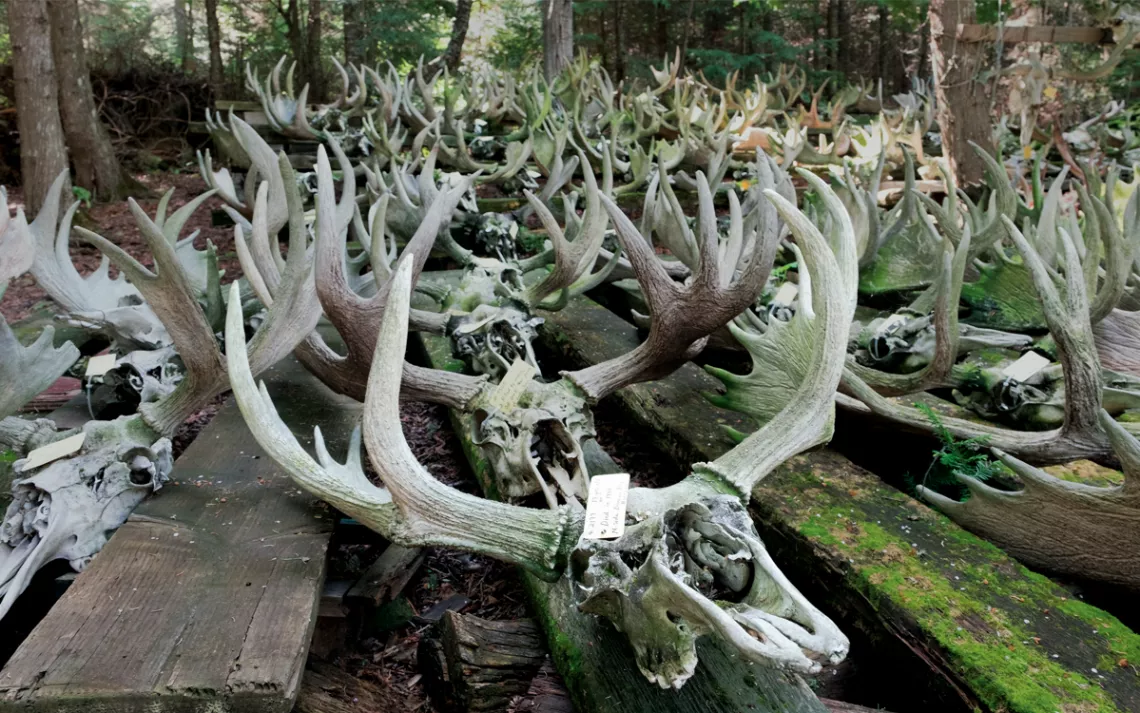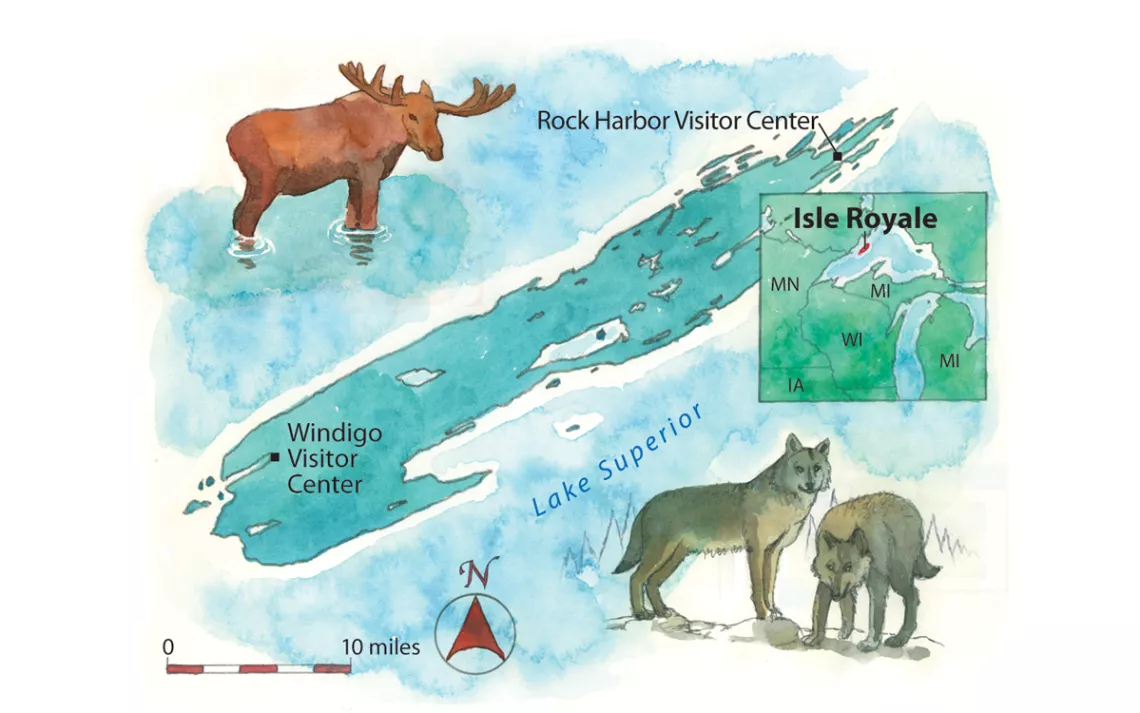Looking for Moose Skulls at Isle Royale National Park
A journey into one of the longest-running citizen-science initiatives in the US

Since 1988, citizen scientists have retrieved and helped analyze more than 5,000 moose skulls in Isle Royale National Park. | Photo by Jonathan Irish/National Geographic Creative
The final mile of my first Moosewatch Expedition was an uphill slog through the dark. Normally my load would be lighter at the end of a long backpacking trip. But after a week of hiking the stony ridges and cedar swamps of Michigan's Isle Royale National Park, my pack was heavier than ever. That's because it was stuffed with moose bones: a half dozen vertebrae, two jawbones, and a metatarsal. An unwieldy arthritic-moose pelvis that couldn't fit inside my pack was strapped to the exterior.
We were late getting back to base camp because we had found two more moose skeletons that last day. It took over an hour to process each find. We had to gather scapulae that had been scattered by wolves, reach into swampy holes to find smaller bones, and dig in the soft dirt to recover any teeth that had dislodged from a jaw. We also had to evaluate bones for signs of disease, photograph the area where the remains had been found, and take notes. By the time we had labeled and carefully packed up all the bones, the sun had set, leaving us to hike in the deepening gloaming.
For more than 60 years, biologists have been observing the interaction of moose and wolves on Isle Royale in the longest-running predator-prey wildlife study ever conducted. The terrain—a 45-mile-long island of furrowed wilderness set in the deep, frigid waters of Lake Superior—provides an unmatched ecosystem for research. Its isolation limits the number of variables and makes the collection and interpretation of data easier than in a mainland ecosystem. Through decades of study, biologists have been able to chart the ebb and flow of wolf and moose populations while measuring how chance events (like the accidental introduction of a canine virus in the 1980s that sent wolf numbers plummeting) can disrupt its delicate balance.
But professional biologists can't do it all alone—so they rely heavily on citizen scientists to help with the crucial work of locating and cataloging wolf kills. Since 1988, between 40 and 60 volunteers from across the country have traveled to Isle Royale each summer to gather moose bones. During the course of the study, more than 5,000 moose skulls have been retrieved for analysis. Findings from these bones have contributed to dozens of scientific papers on subjects such as the shrinking size of the average moose on Isle Royale over time and how poor nutrition in a moose's early life increases the likelihood of it developing osteoarthritis as it ages.

Map by Steve Stankiewicz
A Moosewatch Expedition feels like a typical trip into the wilderness: You camp in primitive conditions and hike up to 10 miles a day no matter the weather. But in some ways, it's more like a hunting or birdwatching trip, as you're always on the lookout for an elusive quarry—though in this case, it's already dead. "I like hunting mushrooms," a fellow participant who had been on nine expeditions told me at one point, "and this is like mushroom hunting on steroids."
On our first day, we hiked from Malone Bay, on the southern edge of the island, north to Little Todd Harbor. Take a peek at a topo map of Isle Royale and you'll wince at this route. Hiking the island lengthwise is relatively easy, as you can stay on top of the rock ridges that striate the island. If you hike the width of the island, however, you have to traverse those steep, rocky ridges—up, down, and up again, like following the contours of an accordion. It was only mid-May, and the north sides of the ridges still had deep pockets of snow.
No matter where we went, we were looking for moose bones. We thrashed through thick brush, plunged thigh-deep into snowbanks, balanced our way across cedar swamps, and performed wilderness gymnastics among massive trees blown down by fierce Lake Superior winds that had left the forest looking like a giant's game of pick-up sticks. By the end of the weeklong trip, our group had covered 45 miles, most of it off-trail. In the course of those travels, we had discovered and cataloged the remains of five moose.
On the last day of the expedition, as we made our final trek in the dark, I waited a moment to let the rest of the team start up the steep hill; if I had to groan while climbing, I didn't want anyone to hear me. When we arrived at the cluster of National Park Service buildings near the Windigo Visitor Center, which served as our base camp, Candy Peterson, the wife of one of the wildlife study's lead scientists, was waiting. She was thrilled that we, the last of four teams, had finally made it back. When I reached her, she put her hands on my sore shoulders and asked, "Was that the most difficult thing you've ever done?"
I thought about the couple of thousand miles I'd hiked in my life. "Yes," I answered.
And I couldn't wait to come back and do it again.
This article appeared in the May/June 2020 edition with the headline "Remains to be Seen."
Take a Sierra Club trip to Isle Royale, Michigan. Details at sc.org/adventure-travel.
WHERE
Isle Royale National Park, Lake Superior, Michigan
GETTING THERE
Ferries travel from Copper Harbor and Houghton, Michigan, and from Grand Portage, Minnesota. Moosewatch volunteers gather at a designated ferry and travel to the island as a group.
HOW TO JOIN
Visit isleroyalewolf.org to apply to join a Moosewatch Expedition. Click the Contribute & Participate tab to learn more and download an application.
WHEN TO VISIT
Moosewatch Expeditions take place twice in May, then once in June and once in August.
COST
If you're accepted on an expedition, Moosewatch requires a $450 tax-deductible donation to cover food and other supplies.
PERMITS
Wilderness permits are provided for Moosewatch Expeditions.
PRO TIP
Invest in excellent rain gear.
SUGGESTED READING
The Wolves of Isle Royale: A Broken Balance by Rolf O. Peterson
 The Magazine of The Sierra Club
The Magazine of The Sierra Club



